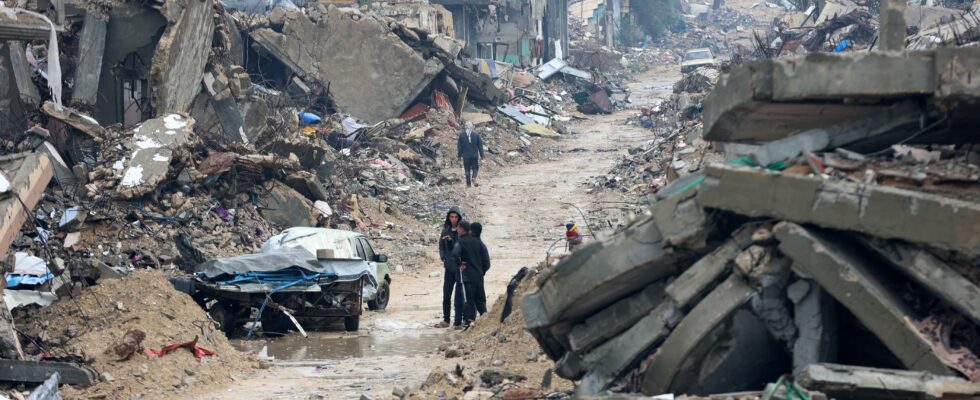The cease-fire agreement in Gaza, the fruit of laborious negotiations, was concluded in January before Donald Trump’s return to the White House. It provides a truce in the Gaza strip for an initial duration of 42 days, entered into force on 19
January. This Monday, February 17, the Israeli security firm must meet to discuss the terms of the rest of its application, when the head of American diplomacy is maintained in Saudi Arabia of the Donald Trump project to take control of the territory Palestinian.
Continuation of the first phase of the agreement
The first phase continues and will end on March 1. It includes first hostage releases, an Israeli withdrawal from densely populated areas, an increase in humanitarian aid and negotiations concerning the terms of the second phase. Israel announced on Sunday the sending of a team of negotiators on Monday to Cairo, in order to discuss the continuation of the first phase of the agreement, after 15 months of war.
The truce almost shattered last week after threats from Hamas to suspend the release of hostage and those of Israel to resume war, the two camps accusing each other of violations of the agreement. After mediation led by Qatar and Egypt, Hamas finally released three Israeli hostages on Saturday and Israel 369 Palestinian prisoners, during the sixth exchange since the start of the truce.
These exchanges have already enabled the release of 19 Israeli hostages and 1134 Palestinians. A total of 33 hostages, from which eight died, must be given to Israel during this phase in exchange for 1900 Palestinian prisoners. Out of 251 people kidnapped during the Hamas attack in southern Israel on October 7, 2023, which sparked the war, 70 are still retained in Gaza, of which at least 35 dead, according to the Israeli army.
Israeli security firm meeting
The Israeli security cabinet must discuss on Monday of the second phase of the agreement, supposed to allow the release of all the hostages selected in the territory and the final end of the war. “After the cabinet meeting […]the team will receive instructions for the continuation of negotiations concerning the subjects of the second phase, “the office of the Israeli Prime Minister said on Sunday.
On Sunday, Benyamin Netanyahu, threatened to open the “gates of hell” in Gaza if all the hostages were not released, during a press point after a meeting with the chief of diplomacy American, Marco Rubio, in Jerusalem. “We have a common strategy (with the United States, editor’s note), of which we cannot reveal all the details to the public, including the way in which the doors of hell will open, as they will surely do if all Our hostages are not released, without exception “.
Arab country summit on the future of Gaza
A summit of several Arab countries, initially scheduled for February 20, was offset this Friday, February 21 in Ryad on Friday, February 21, to provide a unanimously rejected answer from Donald Trump to empty Gaza of its inhabitants to rebuild the territory under American control. Initially planned for five states, the summit has been extended and should bring together, according to a Saudi official, the six countries of the Gulf Cooperation Council (Saudi Arabia, Oman, Kuwait, Bahrain, the United Arab Emirates and Qatar) , as well as Egypt and Jordan, alongside the Palestinian authority.
The meeting in Ryad will underline the rejection of a “displacement of the Gazaouis” and their “transfer” outside this territory, according to a source from the France Press Agency close to the Saudi government. Egypt has announced that it would present a “global vision” for the reconstruction of Gaza so as to guarantee that the Palestinians remain on their land.
Last step, reconstruction
If the calendar takes place as planned, the third and last stage of the cease-fire agreement will be devoted to the reconstruction of Gaza and the restitution of the bodies of Israeli hostages who died in captivity.
The Gaza reconstruction site is estimated by a recent UN report at more than $ 53 billion. While “more than 60 % of homes” have been destroyed since October 2023, the housing sector will require around 30 % of reconstruction needs, or 15.2 billion. Next come trade and industry (6.9 billion), health (6.9 billion), agriculture (4.2 billion), social protection (4.2 billion), transport (2.9 billion), water and sanitation 2.7 billion and education (2.6 billion).
The report also notes the particularly high early costs for the environmental sectors (1.9 billion), “due to the large quantity of rubble containing unplodced machines and the high cost associated with the removal of debris” .
